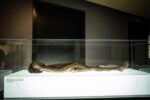Jaanus Samma – Outhouse by the Church
 (800x533).jpg)
Prima personale dell’artista in Italia dopo l’acclamato NSFW. A Chairman’s Tale, progetto con cui ha rappresentato l’Estonia alla 56. Biennale di Venezia (2015).
Comunicato stampa
Nomas Foundation è lieta di presentare Outhouse by the Church, mostra di Jaanus Samma a cura di Eugenio Viola, che inaugurerà giovedì 27 settembre 2018, alle ore 18.00, prima personale dell’artista in Italia dopo l’acclamato NSFW. A Chairman’s Tale, progetto con cui ha rappresentato l’Estonia alla 56. Biennale di Venezia (2015).
Nel suo lavoro, Jaanus Samma utilizza diversi media ed il suo interesse è legato alla ricerca di archivio. Difatti, l’artista adotta spesso una prospettiva micro-storica, connettendo la dimensione pubblica e collettiva della Storia alle qualità private e narrative della cronaca. Gli ambiti principali della sua ricerca investono le nozioni di pubblico e privato, spesso collegate ad argomenti relativi a questioni queer.
Outhouse by the Church è un progetto che indaga, in chiave antropologica, i bagni pubblici: un soggetto apparentemente umile, talvolta sottostimato, che permette di affrontare questioni relative alla gerarchia, alla disuguaglianza, al corpo, in termini estetici e politici. Uno spazio in cui sfuma il confine fra pubblico e privato e che è stato spesso trascurato. Per questa ragione, nella sua lunga storia e in diversi contesti sociali e culturali, si è prestato ad opportunità di interazione sociale di vario tipo.
I bagni pubblici, in quanto spazi condivisi marginali, sono tradizionalmente classificati secondo un’eteronormatività binaria di genere (maschio, femmina) e, tra i molteplici (e prevedibili) usi possibili, a volte diventano aree di battuage, nonostante la sempre maggiore diffusione delle applicazioni per appuntamenti, ormai comuni su tutti gli smart-phone, abbia indubbiamente determinato, negli ultimi anni, un declino di tale utilizzo.
Flaminio Station (2016–2018), è una serie di lavori che l’artista ha concepito dopo una residenza a Roma, invitato da Nomas Foundation, in cui ha esplorato la geografia dei siti di battuage della capitale. Queste opere di ceramica, ricoperte di graffiti, richiamano le mattonelle gialle che rivestono i bagni pubblici della stazione Flaminio, uno degli ultimi a Roma a non essere stato modernizzato, nonché popolare area di cruising. Inoltre, l’artista ha ricopiato sulla superficie di questi lavori la vasta gamma di scritte e graffiti che popolano i bagni pubblici della stazione di Flaminio, schermandoli discretamente con una tenda di “catene” da wc in plastica.
L’opera che dà il titolo alla mostra, Outhouse by the Church (2018), è un’installazione composta dai resti di un vecchio bagno pubblico in legno, collocato all’esterno della chiesa di San Michele, nel villaggio di Kodavere, in Estonia orientale. Questo bagno è stato usato per quasi un secolo, prima di essere abbandonato ed i suoi resti recuperati infine dall’artista. Curiosamente, mentre la chiesa di Kodavere e i suoi immediati dintorni sono considerati beni culturali e dunque protetti e ben documentati, i bagni esterni non sono mai menzionati, e ciò induce a riflettere, ancora una volta, sulla generale invisibilità di questi spazi.
Similmente ai bagni della stazione Flaminio, anche i gabinetti esterni la chiesa di San Michele erano evidentemente poco controllati, al punto che i suoi utenti se ne sono progressivamente “appropriati”. La parte più sorprendente di questi resti, tuttavia, è costituita dai graffiti, ormai “storici” e ben conservatisi, di cui alcuni datati agli anni Venti del secolo scorso. Alcuni commenti iscritti nel legno suggeriscono che questa struttura, originariamente eretta vicino a un’istituzione dall’alta autorità morale, talvolta è stata utilizzata per connettere il sacro e il profano.
Al di là dell’aspetto irriverente e ironico, Outhouse by the Church mette in scena un’installazione ambientale che si concentra sullo spazio quotidiano dei bagni pubblici, sui loro usi e costumi e relative norme sociali. Jaanus Samma offre un punto di vista incentrato sulle nostre pratiche quotidiane, mostrandoci, attraverso lo strumento altamente simbolico dell’arte, alcuni meccanismi che riflettono e sostengono le nostre attitudini culturali verso il sesso, le classi sociali e le questioni di genere.
-
Jaanus Samma
Outhouse by the Church
curated by
Eugenio Viola
September 27th – December 14th, 2018
Nomas Foundation
Viale Somalia, 33 – Rome
Opening Thursday September 27th, 2018 at 6pm
Nomas Foundation is pleased to present Outhouse by the Church, a project by Jaanus Samma, curated by Eugenio Viola, that will open on Thursday 27 September 2018, at 6 pm. This is the artist’s first Italian solo exhibition, after the acclaimed NSFW. A Chairman’s Tale, that represented Estonia at the 56th Venice Biennale (2015).
Samma’s practice spans across multiple media, with an active interest in archival research. In his work, he adopts a micro-historical perspective, connecting the public and collective dimensions of History with the private and narrative qualities of a chronicle. Notions of the public and private realm, often connected with queer topics, are the main subjects of Samma’s research.
Following a long anthropological fieldwork, Outhouse by the Church is a project focused on public toilets, an ostensibly humble and sometimes underestimated subject that can teach us about hierarchy, inequality, the body, aesthetics and politics. The public toilet is a space where the border between public and private is blurred, a space which is often discreetly disregarded and for this reason, during its long history and in different social and cultural contexts, has created opportunities for a variety of social interaction.
As marginal public space, public toilets are traditionally classified according to heteronormative gender binary (male, female) and among the possible uses, sometimes serve as cruising areas, although the rise of dating apps has undeniably led to a decline in this.
Flaminio Station (2016–2018) is a series of works the Estonian artist conceived after a residency at Nomas Foundation in Rome, where he explored the geography of the city’s cruising sites. These graffiti-covered ceramic pieces are evocative of the bright yellow tiles that cover the shabby public toilet at Flaminio Station, which is one of the last unmodernised public toilets in Rome, and a popular cruising site. For these works, the artist copied the vast array of writing and graffiti he found in the Flaminio public toilet, while a curtain of rubber toilet pulls discreetly screen the drawings.
The title piece of the exhibition, Outhouse by the Church (2018), is an installation made of remnants of an old wooden outhouse, formerly located next to St Michael’s Church in the village of Kodavere in Eastern Estonia. This outhouse was used for almost a century before it was abandoned and its remnants recuperated by the artist. Kodavere church and its immediate surroundings are under heritage protection but curiously the outhouse is never mentioned in its extensive documentation reflecting on the general invisibility of these kinds of spaces.
Similarly to the Flaminio Station toilets, the Kodavere outhouse was left unsupervised to be appropriated by its public. Some well-preserved historical graffiti, dated from the 1920s, is the most surprising part of this relic. Furthermore, some comments inscribed in this old wood suggest that these facilities, which were standing next to an institution of high moral authority, were sometimes used to intertwine the sacred and the profane.
Beyond the irreverent and ironical appearance, Outhouse by the Church stages an environmental installation, which draws focus to the everyday environment of the public restroom and its related social norms, people’s movements and actions. Jaanus Samma offers here an assessment of our contemporary practices, showing us some mechanisms that reflect and sustain our cultural attitudes towards sex, class, and gender.



